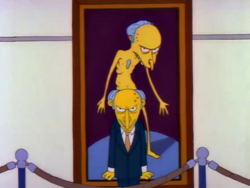
Difference between revisions of "Burns portrait"
m (→Aesthetics) |
m (→Appearances: Minor changes, replaced: *{{Ep| → *{{ep| (2), *{{Game| → *{{game|) |
||
| Line 15: | Line 15: | ||
== Appearances == | == Appearances == | ||
| − | *{{ | + | *{{ep|Brush with Greatness}} |
| − | *{{ | + | *{{ep|The Mansion Family}} |
| − | *{{ | + | *{{game|The Simpsons: Hit & Run|(on collector card)}} |
== References == | == References == | ||
Revision as of 14:09, September 23, 2012
- "And, uh, incidentally, thanks for not making fun of my genitalia."
- ―Montgomery Burns
- "I thought I did."
- ―Marge Simpson[src]
The Burns Portrait is a painting of C. Montgomery Burns by Marge Simpson.
Contents
Aesthetics
The portrait depicts Burns completely naked, hunched over slightly, against a purple backdrop. Although Marge thought she had ridiculed Burns' genitals, Burns thanked her for properly depicting them.[1]
Reaction
- "He's bad—but he'll die—so I like it."
- ―Elizabeth Hoover[src]
The portrait was unveiled as part of a wing dedication to Burns at the Springfield Palace of Fine Arts. (Burns "ponied up the dough" to have the museum built.)
When the painting's curtain was lowered, and the crowd saw the portrait for the first time, their original reaction was one of shock. Smithers fainted upon seeing it. However, Marge explained her intention behind the piece was to show that, underneath his imposing evil, Burns was as fragile as any human being. Seen in this light, the crowd found a new appreciation for the painting.[1]
Appearances
 Episode – "Brush with Greatness"
Episode – "Brush with Greatness"  Episode – "The Mansion Family"
Episode – "The Mansion Family"  Video game – The Simpsons: Hit & Run (on collector card)
Video game – The Simpsons: Hit & Run (on collector card)

